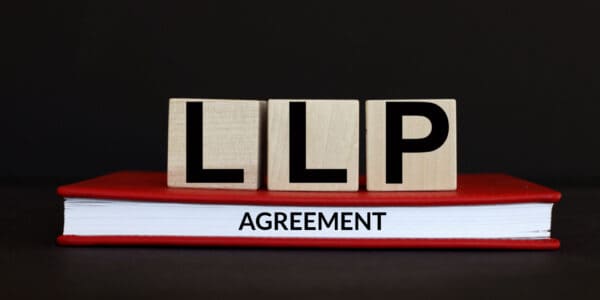An LLP agreement is a formal, legally binding agreement between the partners of a limited liability partnership (LLP). It defines the rights and responsibilities of members and the rules for running the business, in line with the Limited Liability Partnerships Act 2000 and other LLP legislation.
In this article, we look at the LLP agreement in detail, including what it normally includes, why it’s important, and how to create one for your UK limited liability partnership.
What is included in an LLP agreement?
An LLP agreement is sometimes referred to as a limited liability partnership agreement, deed or partnership, members’ agreement, or partnership agreement.
It is commonplace to draw up such an agreement when you set up a limited liability partnership. This is because, unlike companies, LLPs do not adopt articles of association as their governing document.
While LLP members (partners) have no legal obligation to draft and enter into a formal agreement, it’s strongly recommended. It is an extremely important document because it outlines the rules of the partnership and its members.
If you do not draft your own agreement, the default provisions in the LLP Act 2000 and Limited Liability Partnerships Regulations 2001 will apply instead.
These can be unnecessarily restrictive for partnerships requiring more tailored rules and greater clarity than the statutory provisions provide.
Typically, an LLP agreement will cover the following areas:
- Names of all partners who have entered into the agreement
- Rights, responsibilities, and duties of ordinary members and designated members
- Capital investment and non-financial contributions of partners
- How much ownership and control each partner has
- Limited liability of members – how much they are personally required to contribute toward the LLP’s debts if it becomes insolvent
- Profit-sharing and/or remuneration arrangements
- How losses will be shared between members
- Criteria and admission procedures for appointing new LLP members
- Expulsion criteria
- Rules and procedures when a member resigns or retires
- Obligations of outgoing partners, e.g. confidentiality and non-compete provisions
- How decisions are made and which members have the right to make them
- Annual leave, pensions, and other entitlements
- Dispute resolution procedures
Additionally, an agreement will usually cover key basics about the LLP, including:
- Official LLP name registered at Companies House
- Any alternative trading name(s)
- Registration number
- Registered office address
- Business/trading address
- Nature of business activities carried out by the partnership
Essentially, a good LLP agreement should be tailor-made and address every single area relevant to the successful running of a specific partnership.
Do I need an LLP agreement?
By law, LLP agreements are not compulsory, but it is generally agreed and recommended that every LLP has one. Drafting a bespoke agreement is the best way to protect your business and the interests of each member.
If you don’t create an LLP agreement for your partnership, the default provisions in the LLP Act 2000 and Limited Liability Partnerships Regulations 2001 will automatically apply.
The default provisions under parts 7 and 8 of the LLP Regulations 2001 state that:
- All members of an LLP are entitled to share equally in the capital and profits of the limited liability partnership
- Every member may take part in the management of the LLP
- No member is entitled to receive any remuneration for managing the LLP
- No new member can be introduced without the unanimous consent of all existing members
- Ordinary matters connected with the business of the LLP may be decided by a majority of the members, but no change can be made in the nature of the LLP’s business without the consent of all members
- No majority of members can expel any member unless the power to do so has been conferred by express agreement between the members
- The partnership will indemnify the members in respect of any expenses they incur
These default rules may be perfectly suitable for some LLPs. However, they can be problematic for many others – particularly with regard to equal profit-sharing and decision-making rights.
It is not unusual for members to invest differing amounts of capital, time, and effort in a business. In such instances, capital rights, profit entitlement, and decision-making powers should fairly reflect the contributions (both financial and otherwise) of each member.
Creating an LLP agreement will allow you to do this, whereas the statutory provisions could leave the business and certain members in an unsatisfactory position.
What are the benefits of drafting an agreement?
Drafting an LLP agreement provides many benefits, ensuring members have far greater control over the business and the way in which it operates.
Specifically, a carefully written LLP agreement will:
- Set out clear rules and procedures tailored to the unique needs of the partnership and its members
- Protect each member’s respective interests, investments, and contributions
- Clarify the relationship between the partners, including their responsibilities and expectations
- Minimise the risk of misunderstandings, disputes, and conflicts between members
- Effectively manage and resolve potentially damaging disputes before they escalate
Going into business always involves some degree of risk, but this uncertainty is compounded when other people are involved. That’s why it is so important to cover all bases and start your partnership on a secure footing.
How and when to create a limited liability partnership agreement
Ideally, you should put an LLP agreement in place as soon as you register your partnership at Companies House. It’s best to set out the rules from the very beginning – and there’s a greater chance of members being in agreement at the start of the business venture.
There is no ‘model’ LLP agreement available from Companies House. However, you can obtain a draft one online and alter it accordingly. Or, you can ask your solicitor or accountant to help you create a bespoke LLP agreement.
Alternatively, you can get a free draft LLP agreement from Quality Company Formations. This is included with our Limited Liability Partnership Package.
Using our online company formation service, you can set up an LLP in just 3 to 6 working hours. Once Companies House approves your application, we will issue a draft LLP agreement by email, which you can edit according to your needs.
Do I need to send a copy of my LLP agreement to Companies House?
Unlike the articles of association used by limited companies, an LLP agreement is private. It is not a matter of public record, so there is no need to send a copy of your agreement to Companies House.
However, it is important that all members have access to the LLP agreement. Therefore, you should issue a copy to each member and retain a copy at your registered office address.
In summary
LLP agreements are optional but highly recommended. Especially in situations where members will not be sharing profits equally.
If you decide to set up a limited liability partnership, you should create an LLP agreement as soon as possible. This will clarify the rights and responsibilities of members and the rules for running the business.
If you have any questions about this topic or any other aspect of setting up a limited liability partnership in the UK, please leave a comment below or contact our company formation specialists.
Please note that the information provided in this article is for general informational purposes only and does not constitute legal, tax, or professional advice. While our aim is that the content is accurate and up to date, it should not be relied upon as a substitute for tailored advice from qualified professionals. We strongly recommend that you seek independent legal and tax advice specific to your circumstances before acting on any information contained in this article. We accept no responsibility or liability for any loss or damage that may result from your reliance on the information provided in this article. Use of the information contained in this article is entirely at your own risk.








Join The Discussion